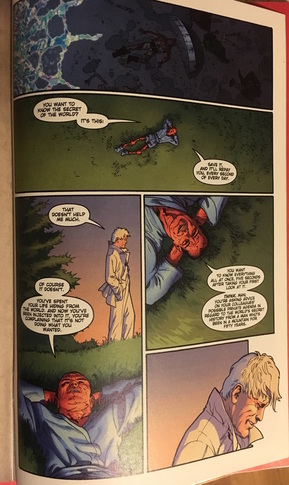 This edition of 1panel1page focuses on a comic book series I consider one of the most culturally important runs in the modern sequential art: Planetary, by Warren Ellis and John Cassaday. As I said in the first edition of 1panel1page, the concept here is to take a look at a single, personally memorable page and panel that has stuck with me over the years. An unforgettable image or scene, something that never left my mind. Now, this could honestly apply to almost all of Planetary, a series I think delves so deep into comic books as an art form and story medium that it could be called essential reading. But while Planetary was smart, and nerdy, and layered in its analysis of the medium, it was the very human moments that rang most true, especially when they involved Elijah Snow the 100-year-old Century Baby, dragged unwillingly into this archeological dig of the strangest places in the world. The book is loaded with analogs, from everything from the Fantastic Four to Godzilla. And along the way, a key figure Elijah Snow and his team meets is Axel Brass, a fellow Century Baby and blatant homage to Doc Savage. The Planetary team finds Brass in pretty rough shape, delving into a history that mirrors the pulp fiction stories of our reality. But it's a conversation between Brass and Snow--two old men who have been heroes, who have seen the beautiful and terrible things the world can be. Sitting on a hill, in a scene beautifully rendered by Cassaday and the astoundingly talented colorist Laura Martin. The thing that stuck with me all these years (Planetary #5 first printed in 1999) was the serenity of it. Comics tend to be bombastic, relentlessly energetic, full of motion. But here's an old man basking in the sun in a robe, happy to be alive, and another man, just beginning the last great adventure of his long life, looking out into the distance, knowing there's so much more to come. 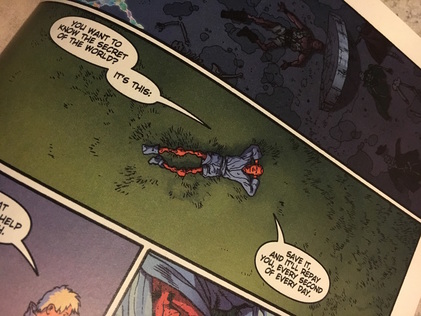 And to this day I still quote Brass's line here: "You want to know the secret of the world? It's this: Save it, and it'll repay you, every second of every day." Some of Warren Ellis's best characters are angry men of great ideals. It's something I related to as a younger reader, and it's something I relate to even more now: the world is wonderful and needs saving. It needs us to be good. It needs us to be better. I feel like Axel Brass's optimism here is something core to the entire Planetary series, and something that spills over into the best of superhero fiction, particularly superhero fiction with a deconstructionist angle. The secret of the world. For years I had this on a hand-written note hanging over my desk; in writing this article, it's returned there again. Save the world, and it'll repay you, every second of every day. (This idea definitely weaved itself into some of the key concepts of the Indestructibles. They live in a world that can, like ours, be a terrible place; but it is full of wonder, and it is always, always, always worth saving. I stand by this even on the darkest of days.) 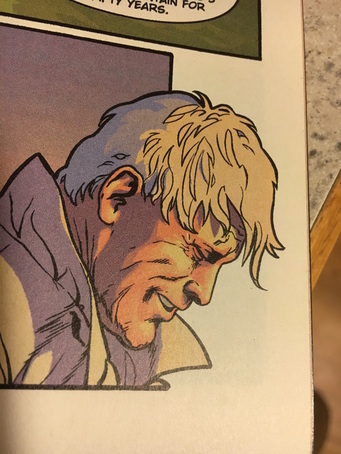 But if I'm telling you the complete truth, the reason this panel has stuck with me for so long is because I connected so much with Elijah Snow when I first read this book--still do, if I'm being honest--and it is, I believe, one of the first times we see Elijah smile in the series. It might be one of the few times we ever see Elijah Snow smile. And it is such a wonderful, human, heartbreaking and joyously crafted smile. It is my favorite panel in the storied career of John Cassaday. Just an old man, smiling to himself, eyes closed, sun splashing across his lined face. I will always love this panel. It helps me make sense of the world, if that makes any sense at all. So: were you a Planetary reader? Did it have an impact on you? Let's talk in the comments below. And I'm always open to inviting guest writers to share their own #1panel1page stories. Let me know if you'd like to share your story as well.
0 Comments
I've been thinking of ways to make the Indestructibles blog more chatty lately, and while I was in Cleveland for conference last week I got an idea: what about writing a series about one single panel from a single comic book that I found really memorable? We all have those--the panel that sticks with you forever, whether because it's iconic, or because it's funny, or tragic, or does something we've never seen before... the reasons are endless. I also then thought: well sometimes it's not just the panel. Sometimes you need the entire page to really explain why it's stuck with you, what made it so important to your brain that it never let go. So: one panel, one page. Or, because the internet demands it, #1panel1page. And I know exactly where to start. It was 1988. 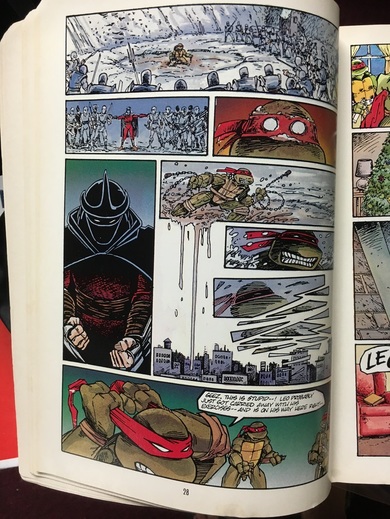 Okay, maybe it wasn't exactly 1988. I might've read the comic a little later. I'm not sure. But it was one of the first trade paperbacks I ever owned, picked up at a little Waldenbooks in Medford, Massachusetts. The comic? Teenage Mutant Ninja Turtles Book IV by First Publishing. Yeah, I bought Book IV first. Apparently I wasn't as big a stickler for continuity back then as I am now. But it was amazing. Not because it was the first time I encountered Eastman and Laird's ninja turtles in print, but because I was young enough that I only knew Leonardo, Michelangelo, Donatello, and (my future spirit animal) Raphael through the bright, cheery, pizza-loving cartoon. I had no idea how dark their original format was, how violent. I didn't know how closely the comics hewed to the classic, quietly menacing style of storytelling that it had originally been more of a parody of. Really, I could pull any page and panel from this TPB and write about it, but here's the page that leapt instantly to mind when I was brainstorming where to start with #1panel1page: 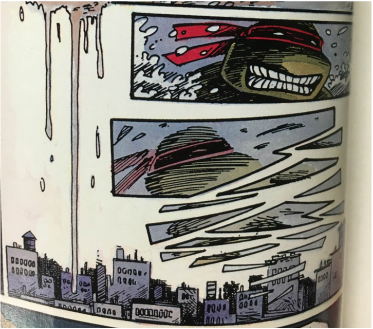 This requires a little context: while his brothers playfully prepare for Christmas with April and Splinter, Leonardo is silently patrolling the city alone. He's set upon by the Foot Clan, which plays out as a silent, terrifying endurance test as the lone turtle is outmatched and outnumbered. His part of the story is wordless--his brothers and their banter more than making up for his lack of dialogue--with page after page of gorgeously rendered ninja fighting in a grimy, gritty portrayal of Manhattan covered in dirty gray snow. And just when you think Leo is going to make it home in one piece... Shredder (whom the turtles had defeated in an earlier book and believed dead) appears. Let's zoom in on the panel that makes this page unforgettable in my mind: It's really more of a composite panel, the white sky over a gray Manhattan, Leonardo smiling both defiantly and almost sheepishly as he faces his mortal enemy. There's real brilliance in the expression portrayed on the page--Leo's inhuman face shows layers of fear and anger and even sarcasm in that last moment. And then, the panel he exists in is literally shredded, torn apart on the page, Leonardo's face becoming blurred and incomplete. The melting snow on the left of the panel is reminiscent of blood, A trick that loses a bit of its impact in the color version of the comic, but still builds a powerful, impactful, and memorable panel.
This kicks off a relentless battle sequence between the Foot and the turtles and leads to one of the more memorable smaller arcs in the early series--but all that's a post for another day. Were you a fan of the early TMNT books? What do you think of their more current stories? Writers, do you have a #1panel1page article to suggest (or would you even want to guest-blog)? Comment below, or use the Contact button at the top of this page. Do you dig the #1panel1page concept? Share the hashtag and the link on social media! |
AuthorMatthew Phillion is the writer of "The Indestructibles," part-time actor, occasional filmmaker. Currently on the lam in Salem with his trusty dog, Watson. Archives
September 2019
Categories |
 RSS Feed
RSS Feed